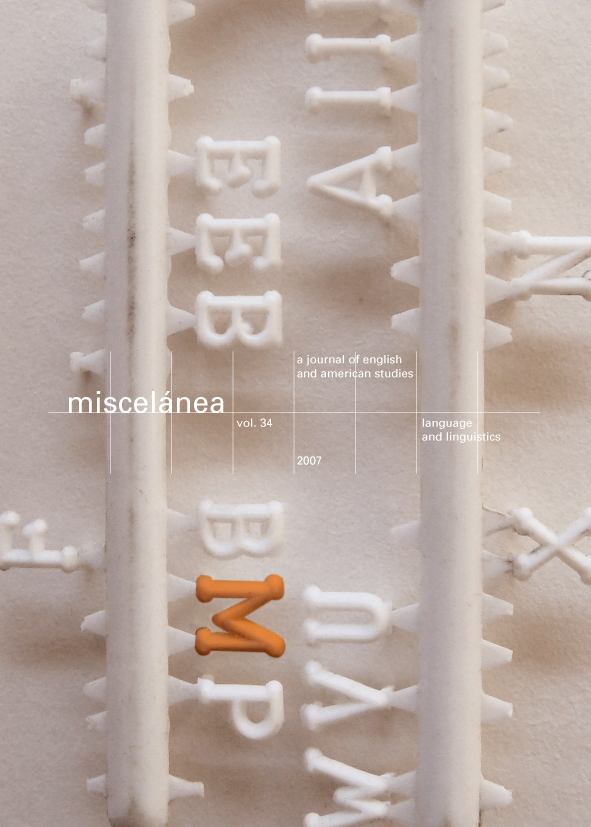Wordsworth’s ‘Tintern Abbey’ and the Tradition of the ‘Hymnal’ Ode
DOI:
https://doi.org/10.26754/ojs_misc/mj.200610110Keywords:
William Wordsworth, Tintern Abbey, Hymnal ode, William Collins, Poetic practiceAbstract
Despite the claims for simplicity of language that Wordsworth articulated in the early years of his literary career, especially in the “Preface” to Lyrical Ballads —his pronounced difference from earlier (Neoclassical) poets, poetic practice, and the forms of poetry of the Augustans— he could not escape what Walter Jackson Bate long ago termed the “burden of the past”. Wordsworth’s indebtedness to his literary forbears is not only ideational but formal as well. The present article aims to examine Wordsworth’s “Tintern Abbey” and relate it to the tradition of the hymnal ode used so masterfully by William Collins in the mid-century, at the same time reconsidering the generic conceptualisation of the poem as an ode in all but name which in its structure and essence re-evokes mid-century hymnal odes but which is contextualised within Wordsworth’s notion of emotional immediacy and simplicity.
Downloads
References
BATESON, F.W. 1954. Wordsworth: A Re-Interpretation. London: Longmans.
BLOOM, Harold. 1985. “The Scene of Instruction: Tintern Abbey”. In Harold Bloom. (ed.). Modern Critical Views: William Wordsworth. New York: Chelsea House Publishing.
BOWRA, Maurice. 1966. The Romantic Imagination. Oxford: Oxford U.P.
BROWN, Marshall. 1993. “Romanticism and Enlightenment”. In Stuart Curran. (ed.). The Cambridge Companion to British Romanticism. Cambridge: Cambridge U.P.
BYATT, A.S. 1997. Unruly Times. Wordsworth and Coleridge in Their Times. London: Vintage.
BYRD, Max. 1983. “Metamorphosis and Tintern Abbey: Two Notes”. Modern Philology 81 (1): 24-37.
CHRISTIANSEN, Rupert. 1994. Romantic Affinities: Portraits from an Age, 1780-1830. London: Vintage.
DANBY, John F. 1968. The Simple Wordsworth: Studies in the Poems 1797-1807. London: Routledge and Kegan Paul.
DE QUINCEY, Thomas. 1960. “Essays on Wordsworth”. In David Nichol Smith. (ed.). Wordsworth. Poetry and Prose. With Essays by Coleridge, Hazlitt, de Quincey. Oxford: Clarendon Press.
DURANT, Geoffrey. 1970. Wordsworth and the Great System: A Study of Wordsworth’s Poetic Universe. Cambridge: Cambridge U.P.
FOSTER, Mark. 1986. “Tintern Abbey and Wordsworth’s Scene of Writing”. Studies in Romanticism 25 (1): 75-95.
FOWLER, Alastair. 1982. Kinds of Literature: An Introduction to the Theory of Genres and Modes. Oxford: Clarendon Press.
GÖLLER, Karl Heinz. 1963. “Die geistige Entwicklung Wordsworths”. Die neueren Sprachen 12: 341-53.
GROOM, Bernard. 1966. The Unity of Wordsworth’s Poetry. New York: St. Martin’s Press.
HAZLITT, William. 1960. “Essays on Wordsworth”. In David Nichol Smith. (ed.). Wordsworth. Poetry and Prose. With Essays by Coleridge, Hazlitt, de Quincey. Oxford: Clarendon Press.
JACOBUS, Mary. 1976. Tradition and Experiment in Wordsworth’s Lyrical Ballads. Oxford: Clarendon Press.
JUNG, Sandro. 2002. “Some Notes on the Hellenism of Mary Robinson’s Odes”. Eighteenth-Century Women 3: 185-197.
—. 2003. “‘Sweetness’ in the Poetry of William Collins”. English Language Notes 41 (3): 36-43.
—. 2004. “Some Notes on William Mason and His Use of the ‘Hymnal’ Ode”. Studia Neophilologica 76 (2): 176-181.
—. 2005. “Post-Augustan Nature in William Collins’s Ode to Evening (1746)”. Philologia 3: 97-106.
—. 2006. “Form versus Manner: The Pindaric Ode and the ‘Hymnal’ Tradition in the Mid-Eighteenth Century.” LiLi: Zeitschrift für Literaturwissenschaft und Linguistik 36 (144): 30-45.
KNAPP, Steven. 1985. Personification and Sublime: Milton to Coleridge. Harvard: Harvard U.P.
LEVINSON, Marjorie. 1986. Wordsworth’s Great Period Poems. Cambridge: Cambridge U.P.
MASON, Michael ed. 1994. Lyrical Ballads. London and New York: Longman.
MEISENHELDER, Susan C. 1988. Wordsworth’s Informed Reader: Structure and Experience in His Poetry. Nashville, Tennessee: Vanderbilt U.P.
MOORMAN, Mary. 1957. William Wordsworth: The Early Years. Oxford: Clarendon Press.
PIPER, H.W. 1962. The Active Universe: Pantheism and the Concept of Imagination in the English Romantic Poets. London: The Athlone Press.
RANDEL, Fred V. 1993. “The Betrayals of Tintern Abbey”. Studies in Romanticism 32 (3): 379-397.
SCHLÜTER, Kurt. 1964. Die englische Ode: Studien zu ihrer Entwicklung unter Einfluß der antiken Hymne. Bonn: Bouvier.
SHERRY, Charles. 1980. Wordsworth’s Poetry of Imagination. Oxford: Clarendon Press.
WILLEY, Basil. 1950. The Eighteenth-Century Background. Studies on the Idea of Nature in the Thought of the Period. London: Chatto and Windus.
WILLIAMS, Raymond. 1983. Culture and Society. London: The Hogarth Press.
Downloads
Published
How to Cite
Issue
Section
License

This work is licensed under a Creative Commons Attribution-NonCommercial 4.0 International License.


